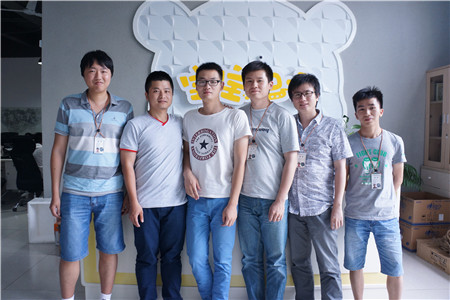读Pyqt4教程,带你入门Pyqt4 _009
QLineEdit
QLineEdit 窗口组件用来输入或者编辑单行纯文本,有撤销/重做,剪切/粘贴和拖放功能。
#!/usr/bin/python
# -*- coding: utf-8 -*-
# ZetCode PyQt4 tutorial
#
# This example shows text which
# is entered in a QLineEdit
# in a QLabel widget.
#
# author: Jan Bodnar
# website: zetcode.com
# last edited: December 2010
from PyQt4 import QtGui
from PyQt4 import QtCore
class Example(QtGui.QWidget):
def __init__(self, parent=None):
QtGui.QWidget.__init__(self, parent)
self.initUI()
def initUI(self):
self.label = QtGui.QLabel(self)
edit = QtGui.QLineEdit(self)
edit.move(60, 100)
self.label.move(60, 40)
self.connect(edit, QtCore.SIGNAL('textChanged(QString)'),
self.onChanged)
self.setWindowTitle('QLineEdit')
self.setGeometry(250, 200, 350, 250)
def onChanged(self, text):
self.label.setText(text)
self.label.adjustSize()
def main():
app = QtGui.QApplication([])
exm = Example()
exm.show()
app.exec_()
if __name__ == '__main__':
main()
该例子现在一个单行编辑器和一个标签。在单行编辑器中键入的文字会立即显示在标签中。
edit = QtGui.QLineEdit(self)
创建 QLineEdit
self.connect(edit, QtCore.SIGNAL('textChanged(QString)'),
self.onChanged)
如果单行编辑器中的文本发生变化,调用 onChanged() 方法。
def onChanged(self, text):
self.label.setText(text)
self.label.adjustSize()
在 onChanged() 方法中,我们把输入的文字设置到标签中。并调用 adjustSize() 方法调整标签的尺寸为文本的长度。
QSplitter
QSplitter 使得用户可以通过拖动子窗口组件的边界来控制子窗口组件的尺寸。在我们的例子中,我们显示由两个分离器组织的三个 QFrame 窗口组件。
#!/usr/bin/python
# -*- coding: utf-8 -*-
# ZetCode PyQt4 tutorial
#
# This example shows
# how to use QSplitter widget.
#
# author: Jan Bodnar
# website: zetcode.com
# last edited: December 2010
from PyQt4 import QtGui, QtCore
class Example(QtGui.QWidget):
def __init__(self):
super(Example, self).__init__()
self.initUI()
def initUI(self):
hbox = QtGui.QHBoxLayout(self)
topleft = QtGui.QFrame(self)
topleft.setFrameShape(QtGui.QFrame.StyledPanel)
topright = QtGui.QFrame(self)
topright.setFrameShape(QtGui.QFrame.StyledPanel)
bottom = QtGui.QFrame(self)
bottom.setFrameShape(QtGui.QFrame.StyledPanel)
splitter1 = QtGui.QSplitter(QtCore.Qt.Horizontal)
splitter1.addWidget(topleft)
splitter1.addWidget(topright)
splitter2 = QtGui.QSplitter(QtCore.Qt.Vertical)
splitter2.addWidget(splitter1)
splitter2.addWidget(bottom)
hbox.addWidget(splitter2)
self.setLayout(hbox)
self.setWindowTitle('QSplitter')
QtGui.QApplication.setStyle(QtGui.QStyleFactory.create('Cleanlooks'))
self.setGeometry(250, 200, 350, 250)
def main():
app = QtGui.QApplication([])
ex = Example()
ex.show()
app.exec_()
if __name__ == '__main__':
main()
例子中有三个框架窗口组件和两个分离器。
topleft = QtGui.QFrame(self)
topleft.setFrameShape(QtGui.QFrame.StyledPanel)
为了看到 QFrame 之间的边界,我们使用带样式的框架。
QtGui.QApplication.setStyle(QtGui.QStyleFactory.create('Cleanlooks'))
使用 Cleanlooks 样式。 在某些样式中,框架是不可见的。
QComboBox
QComboBox 窗口组件允许用户从列表清单中选择。
#!/usr/bin/python
# -*- coding: utf-8 -*-
# ZetCode PyQt4 tutorial
#
# In this example, we show how to
# use the QComboBox widget.
#
# author: Jan Bodnar
# website: zetcode.com
# last edited: December 2010
from PyQt4 import QtGui, QtCore
class Example(QtGui.QWidget):
def __init__(self):
super(Example, self).__init__()
self.initUI()
def initUI(self):
self.label = QtGui.QLabel("Ubuntu", self)
combo = QtGui.QComboBox(self)
combo.addItem("Ubuntu")
combo.addItem("Mandriva")
combo.addItem("Fedora")
combo.addItem("Red Hat")
combo.addItem("Gentoo")
combo.move(50, 50)
self.label.move(50, 150)
self.connect(combo, QtCore.SIGNAL('activated(QString)'),
self.onActivated)
self.setGeometry(250, 200, 350, 250)
self.setWindowTitle('QComboBox')
def onActivated(self, text):
self.label.setText(text)
self.label.adjustSize()
def main():
app = QtGui.QApplication([])
ex = Example()
ex.show()
app.exec_()
if __name__ == '__main__':
main()
这个例子中显示一个 QComboBox 和一个 QLabel 。组合框有5个选项的列表,他们是Linux发行版的名称。标签显示从组合框选择的内容。
combo = QtGui.QComboBox(self)
combo.addItem("Ubuntu")
combo.addItem("Mandriva")
combo.addItem("Fedora")
combo.addItem("Red Hat")
combo.addItem("Gentoo")
创建一个 QComboBox 窗口组件并增加5个选项。
self.connect(combo, QtCore.SIGNAL('activated(QString)'),
self.onActivated)
当一个选项被选择,我们调用 onActivated() 方法。
def onActivated(self, text):
self.label.setText(text)
self.label.adjustSize()
在该方法中,我们把选择项设置到标签中,并调整标签的尺寸。
在PyQt4教程的这部分中,我们涵盖了其他4个PyQt4窗口组件。

本站文章为 宝宝巴士 SD.Team 原创,转载务必在明显处注明:(作者官方网站: 宝宝巴士 )
转载自【宝宝巴士SuperDo团队】 原文链接: http://www.cnblogs.com/superdo/p/4578935.html
比大多数人的努力程度之低,根本轮不到拼天赋...
宝宝巴士 SD.Team


